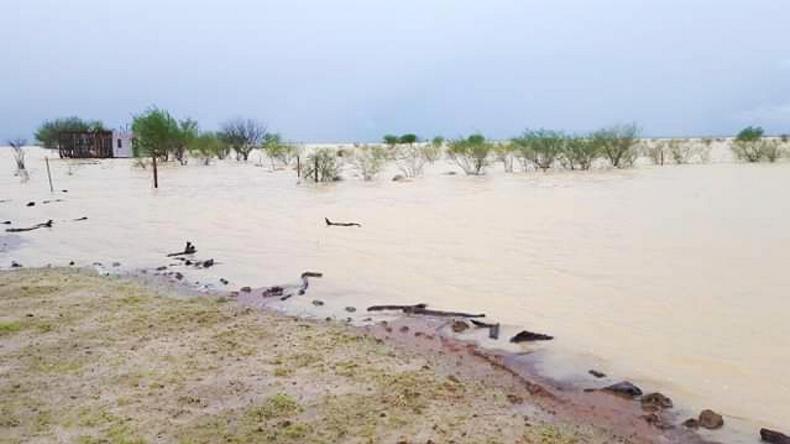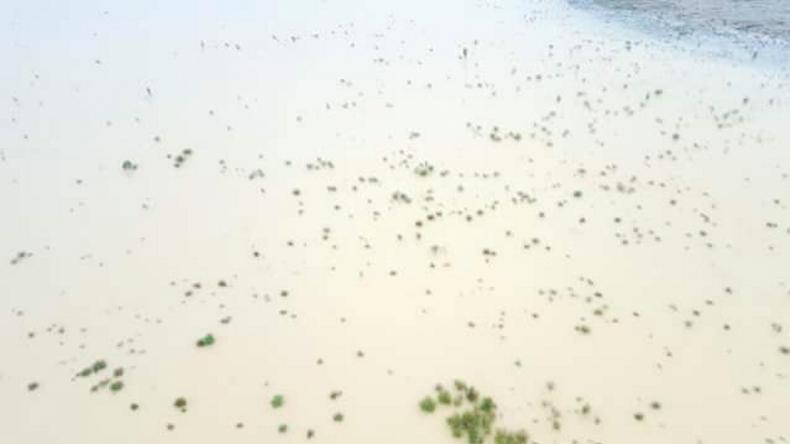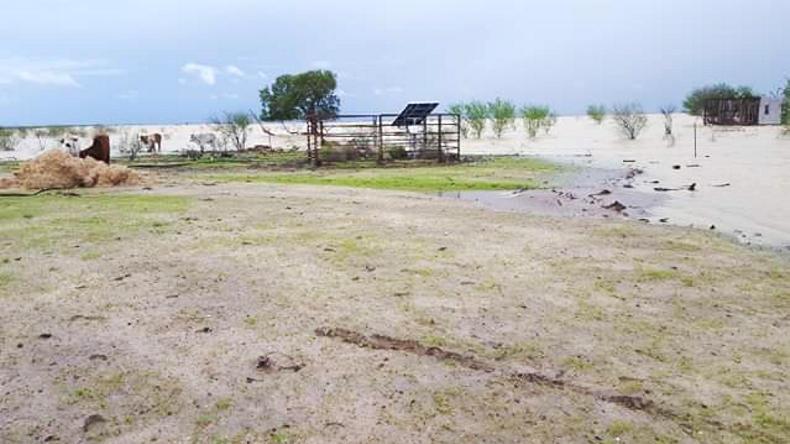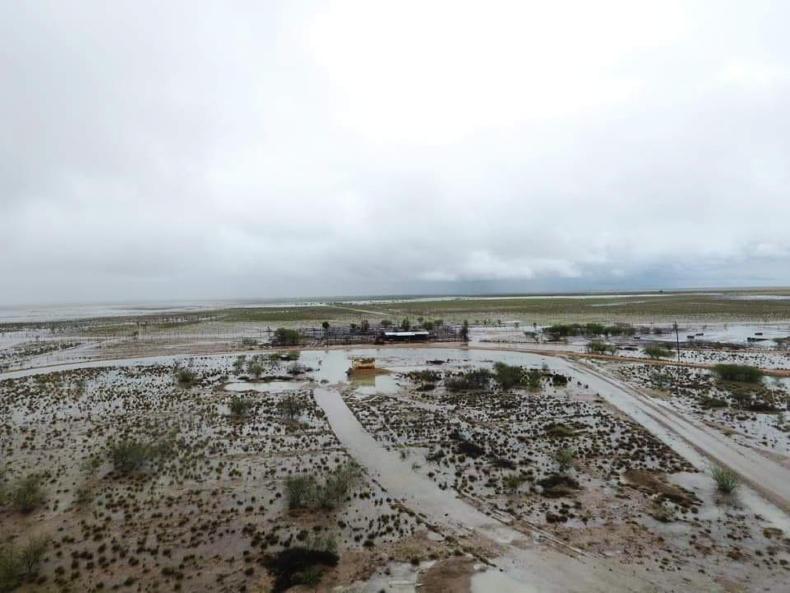My brother and I are the fourth generation to run this station 80km north of Julia Creek. We have an 8,000-head herd of Brahman-cross cattle. They’re spread across two stations, totalling 83,000ha.
We breed, background (store and pasture) and fatten cattle on a grass-based system using some supplement feeding. We supply the live export markets, restockers, feedlots and meat-works for both domestic and international consumption.
We’ve lost around 1,000 cattle out of the 4,200 here because of a record flood, record rainfall in a short period and the sudden temperature drop.

Lara Downs cattle station has an annual rainfall of 525mm. It received 983mm in 11 days.
More than 400,000 cattle were lost in the region as a whole.
The three properties north of us all carry about 4,000 cattle each as well. They lost between 90% and 100% of their stock.
For the last five years we’ve been in drought conditions, with below average rainfall. The rain event was the perfect storm. Everyone was at the end of our long dry season. Grass was short, cattle were at their weakest in terms of body condition.
The rain became a deluge here, with 983mm in 11 days. This included a record flood and cold nights with 75km/h winds and rain to go with it.

Lara Downs cattle station in the aftermath of the floods. Only the tree tops are visible here.
Cattle had endured three months of temperatures in excess of 40°C. They just gave up.
Weaners were the worst affected. They panicked and were climbing on top of each other in the corners of paddocks. There was no way to drive or fly to them with the rain not stopping. Typical Australian conditions.
Normally our wet season runs from January to April. We’ll have an average of 525mm spread out over this period. We have 5ft to 6ft of self-mulching cracking clay here with full moisture profile which can last for a couple of years.
Before the rain, parasites are at their worst but grass pasture is at its best. There’s very little legumes in our native pasture out here which consists of Mitchell and Flinders grasses. This is the time of year at which young cattle will be gaining the most. This would be up to 1kg/day. It’s also our breeding time. We breed our cows for four to six months.
The immediate plan on our station is to feed cattle on islands and wait for the land to dry out. We will helicopter the cattle out of our lowest country in case of another larger weather event before Easter.

Cattle feeding on hay lifted into them by helicopter on Lara Downs cattle station in the aftermath of the Queensland floods.
Helicopters can carry in about 250kg of feed at a time. The army helicopters can lift up to 1.6t.
Some people have up to 200 cows and calves on an island they have to feed until the grass grows.
Our plan for Easter onwards now consists of a few options:
1 There is a lot of demand for people to agist this area due to very little rain in central Queensland, so there’s one form of income. Agistment is where you take on other peoples cattle at a fixed rate.
2 Restocking with possibly some government finance.
3 Cut a lot of pasture for hay and getting a second growth.

Cattle yards at Lara Downs cattle station in the aftermath of the floods
Communities are struggling at the moment. Produce shops are offering long-term bill payment.
Stock agents are wondering what they’re going to do. We have one owner operator who carts our cattle and he’s looking to shift.
Our region has vast areas of land that is only useable for livestock and cattle have proven to be the most profitable by far. The beef industry is big in Queensland and provides $11bn to the economy every year.
Read more
Graphic imagery: floods kill at least 300,000 Australian cattle
Watch: Australian flood leaves ‘a sea of dead cattle’
My brother and I are the fourth generation to run this station 80km north of Julia Creek. We have an 8,000-head herd of Brahman-cross cattle. They’re spread across two stations, totalling 83,000ha.
We breed, background (store and pasture) and fatten cattle on a grass-based system using some supplement feeding. We supply the live export markets, restockers, feedlots and meat-works for both domestic and international consumption.
We’ve lost around 1,000 cattle out of the 4,200 here because of a record flood, record rainfall in a short period and the sudden temperature drop.

Lara Downs cattle station has an annual rainfall of 525mm. It received 983mm in 11 days.
More than 400,000 cattle were lost in the region as a whole.
The three properties north of us all carry about 4,000 cattle each as well. They lost between 90% and 100% of their stock.
For the last five years we’ve been in drought conditions, with below average rainfall. The rain event was the perfect storm. Everyone was at the end of our long dry season. Grass was short, cattle were at their weakest in terms of body condition.
The rain became a deluge here, with 983mm in 11 days. This included a record flood and cold nights with 75km/h winds and rain to go with it.

Lara Downs cattle station in the aftermath of the floods. Only the tree tops are visible here.
Cattle had endured three months of temperatures in excess of 40°C. They just gave up.
Weaners were the worst affected. They panicked and were climbing on top of each other in the corners of paddocks. There was no way to drive or fly to them with the rain not stopping. Typical Australian conditions.
Normally our wet season runs from January to April. We’ll have an average of 525mm spread out over this period. We have 5ft to 6ft of self-mulching cracking clay here with full moisture profile which can last for a couple of years.
Before the rain, parasites are at their worst but grass pasture is at its best. There’s very little legumes in our native pasture out here which consists of Mitchell and Flinders grasses. This is the time of year at which young cattle will be gaining the most. This would be up to 1kg/day. It’s also our breeding time. We breed our cows for four to six months.
The immediate plan on our station is to feed cattle on islands and wait for the land to dry out. We will helicopter the cattle out of our lowest country in case of another larger weather event before Easter.

Cattle feeding on hay lifted into them by helicopter on Lara Downs cattle station in the aftermath of the Queensland floods.
Helicopters can carry in about 250kg of feed at a time. The army helicopters can lift up to 1.6t.
Some people have up to 200 cows and calves on an island they have to feed until the grass grows.
Our plan for Easter onwards now consists of a few options:
1 There is a lot of demand for people to agist this area due to very little rain in central Queensland, so there’s one form of income. Agistment is where you take on other peoples cattle at a fixed rate.
2 Restocking with possibly some government finance.
3 Cut a lot of pasture for hay and getting a second growth.

Cattle yards at Lara Downs cattle station in the aftermath of the floods
Communities are struggling at the moment. Produce shops are offering long-term bill payment.
Stock agents are wondering what they’re going to do. We have one owner operator who carts our cattle and he’s looking to shift.
Our region has vast areas of land that is only useable for livestock and cattle have proven to be the most profitable by far. The beef industry is big in Queensland and provides $11bn to the economy every year.
Read more
Graphic imagery: floods kill at least 300,000 Australian cattle
Watch: Australian flood leaves ‘a sea of dead cattle’










 This is a subscriber-only article
This is a subscriber-only article










SHARING OPTIONS: